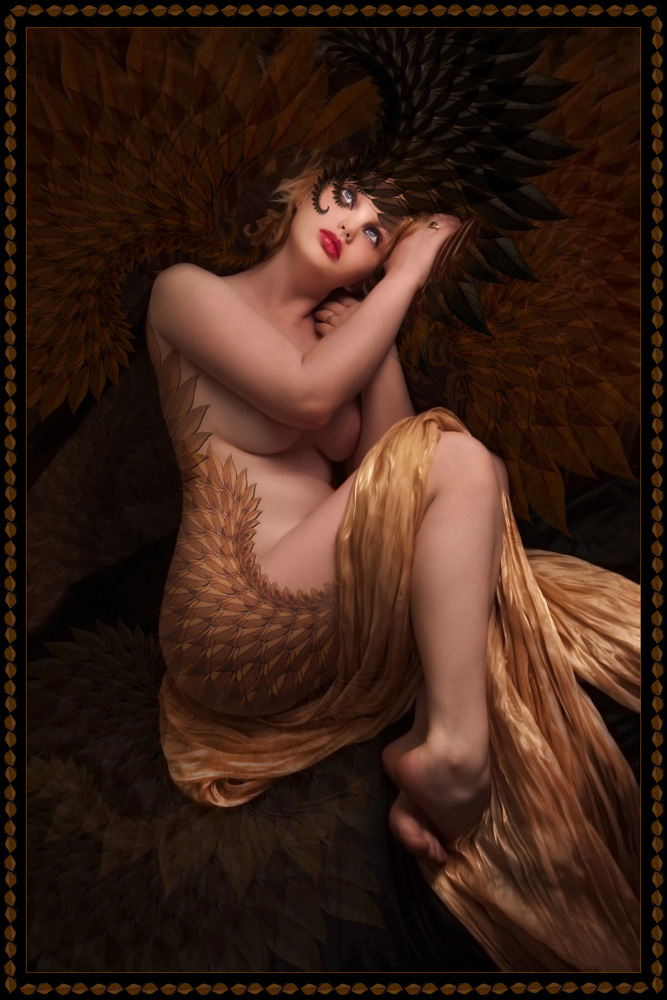
by successfulbob | art books, book review, fine art photography, fine art portrait, inspiration, photography books, photography creativity
Photography Book Review
After the Camera, by Thom Rouse
Digital Transformations for Conceptual Nude & Portrait Photography
Way more than a How-to, After the Camera, is a peek into the mind of a wonderfully creative artist. You can’t help but view Thom’s images and find your story wrapped in and around his multi-layered imagery. His images have the depth and dimension of fine art from the master painters through the ages. This is no surprise if you know Thom. He is a student of the great artists and borrows an idea here, a color palette there, and a look from over there. By combining his art knowledge with his photography, experimenting with the capabilities of our digital age, he transcends visual boundaries, taking us to a new world.
 Isis – Many of the elements were created from the manipulation of a single leaf. This includes the background, parts of her dress, and the hairpiece.
Isis – Many of the elements were created from the manipulation of a single leaf. This includes the background, parts of her dress, and the hairpiece.
Text in this book reads as if Thom is talking directly to you. He shares his inspiration, along with trials and tribulations, during the shoot and post-processing. While this is not a book to teach you techniques in Adobe Photoshop where he does most of his processing, there are many important concepts shared. I’ve found a number of ideas that I can’t wait to try out in my work.
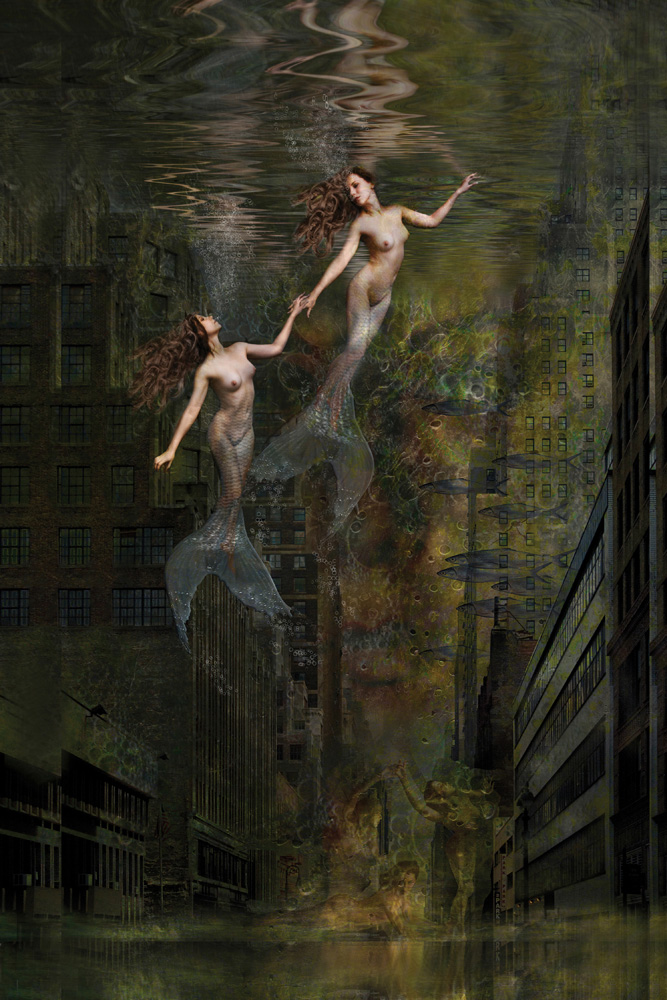 Urban Mermaids – Concept inspired by a regular model.
Urban Mermaids – Concept inspired by a regular model.
Is this book for everyone? Heck no. But most books are not. This is for photographers pushing their work to new realms of art. This is for photographers looking for inspiration. This is for photographers who understand that the nude has been part of the fine art landscape over the millennia. It’s for those who want a peek into the mind of a creative person who has studied fine art painters and can share concepts behind the why of an image.
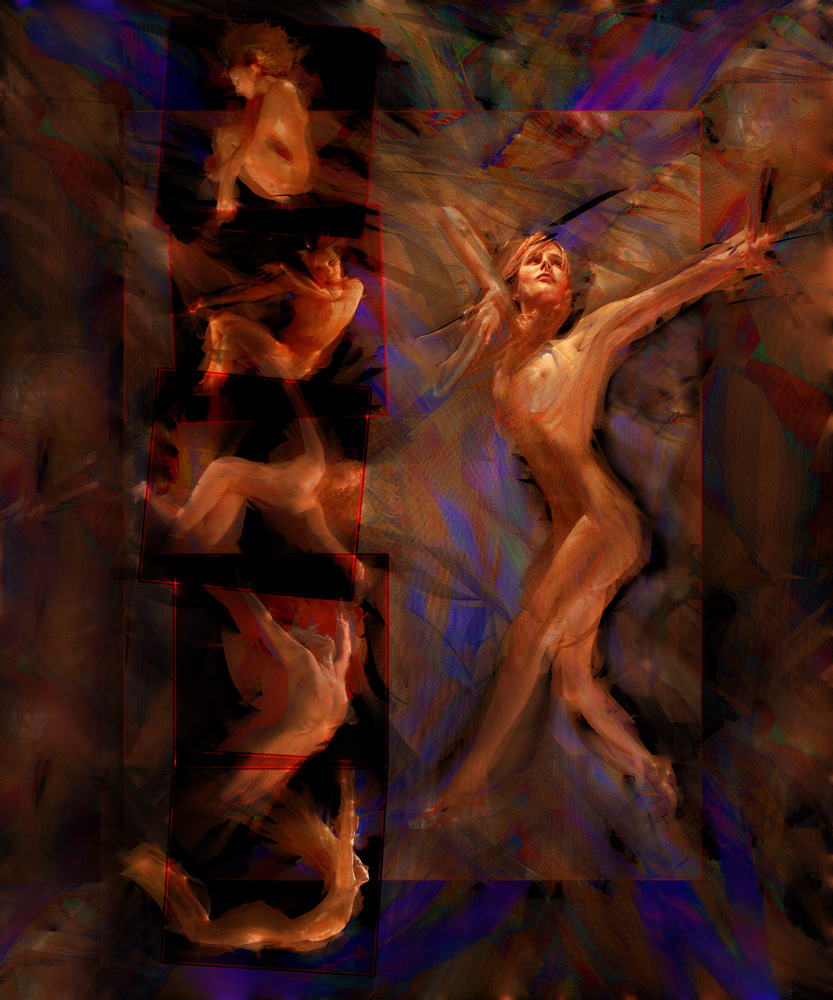 Dance Within – One of the few images where Rouse used Corel Panter to help finish the look of the piece.
Dance Within – One of the few images where Rouse used Corel Panter to help finish the look of the piece.
I can see this book becoming a dog-eared staple on my bookshelf as I plan to go back and review this on a regular basis.
Yours in Creative Photography, Bob
PS – Thom was featured a couple of weeks ago in a Tuesday Photo/Art post. You can read it here.
 Rouse’s book ‘After the Camera’ is available on Amazon.
Rouse’s book ‘After the Camera’ is available on Amazon.
by successfulbob | art books, book review, photography - art quote, photography books, photography education
Sunday Photo/Art Quote – Robert Henri
Thank you Helen Yancy!
Many times it is a small thought shared that opens large passageways of ideas. If you have attended any of my programs you know I am a fan of quotes from artists, photographers, inspirational speakers and authors. Helen was sitting right there in the front row and noting some of the quotes I had collected and was sharing in a slideshow before my program began.
She said, “Oh, you know of Robert Henri and his book The Art Spirit.” “No,” I replied. She had seen one of his quotes go by on the screen and she said, “You really need to get that book and read it!”
So I did.
And, now I’m going to do for you the same thing Helen did for me. Get the book!
Here’s a quote from Henri…
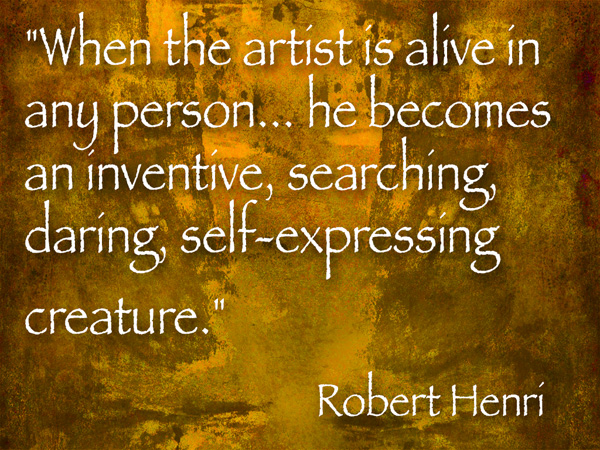 “When the artist is alive in any person… he becomes an inventive, searching, daring, self-expressing creature.” Robert Henri
“When the artist is alive in any person… he becomes an inventive, searching, daring, self-expressing creature.” Robert Henri
When I took Helen up on her suggestion I had ordered the book but let it sit on my side table before grabbing it one day. OMG. There is so much inspiration packed into these pages I don’t know where to start. When I went back through my collection of gathered quotes I found four already in there… And soon I will be adding many more.
Henri pushes you to think in different ways about your art. He was an artist but he was known more for his instruction and influence of other artists who followed in his footsteps. As he said in his book, “I have little interest in teaching you what I know. I wish to stimulate you to tell me what you know.”
And, stimulate you he does.
You never know where the next piece of your education is coming from. One reason I love teaching is I get to learn so much, from my students.
Helen thanks again for the tip.I can’t wait to read it again and really absorb Henri’s message.
Yours in Creative Photography, Bob
PS – By the way Helen is working on a book on the software program Painter with Amherst Media. If you are into Painter and want to push your skills you’ll be able to pre-order soon…
by successfulbob | photography books, photography education
Rocky Nook Books – April Fools Sale
Wanna save some bucks on quality photography books?
It’s the Aprils Fools Flash Sale. (flash as in gone before you not it, not flash photography although that’s in there too!) Save 40% on paperback books. Use Coupon Code 40FLASH & 50% on Ebooks using coupon code 50FLASH but only through April 2nd. Check it out now…
 Good books. Great prices.
Good books. Great prices.
Yours in Creative Photography, Bob
PS – FYI I am a Rocky Nook affiliate so I get a little percentage for sharing this with you that helps support this site and the education provided. Enjoy the discount!
PPS – I highly recommend you looking into Roberto Valenzuela’s books! No Foolin!
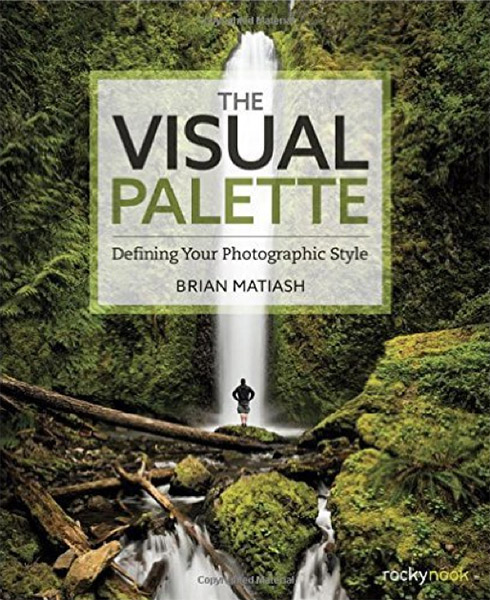
by successfulbob | book review, inspiration, photography, photography books, photography creativity, photography education
Visual Palette Book Review
Lots of information and detail. That’s what I look for in a book.
Are you a photographer just getting started? Find yourself in a photographic rut? Getting the same old photographs from iconic places?
And this one has it.Are you a photographer just getting started? Find yourself in a photographic rut? Getting the same old photographs from iconic places?
Are you a photographer just getting started? Find yourself in a photographic rut? Getting the same old photographs from iconic places?
A pro and find yourself in a photographic rut?
Getting the same old photographs from iconic places?
 Maybe it’s time to take a look at a book called Visual Palette by Rocky Nook Author Brian Matiash.
Maybe it’s time to take a look at a book called Visual Palette by Rocky Nook Author Brian Matiash.
I always appreciate taking a peek into another artist’s thought process when it comes to finding new ways to view and capture a scene that lay before me. Brian gives a great primer on the basics of composition and then moves the process forward with ways to apply the basics in a more advanced way. The
The images included in the book are solid examples of the point that is being made. Are all stellar? Nope. Some are. But, do they do the job? You bet. This book is about, and should be about YOUR photography. You get to experience Brian’s work and thought process but he is sharing ideas and concepts that you can take out for a test drive.
And that’s what it’s all about. Learning new ideas or being reminded of those long forgotten.
Yours in CreativePhotography, Bob
PS – here’s a small excerpt from the book to give you a taste of Brian’s ‘voice’…
“I, Photographer
I am sharing the backstory of my life as a student to illustrate a few
points as it relates to you, the photographer. The first, and probably
most important, point to make is that photography absolutely is a
journey with no set destination. There isn’t a geographic coordinate
to plot to, a set distance of miles to travel, or a number of exposures
to take. There is no master class you can complete where you’ll
receive a certificate stating, “You’ve Made It!”
Don’t feel any despair over this. The fact that this is a never-ending
journey should be something to rejoice! I first picked up a camera to
use with meaningful intent in 1996. At the time of this writing—nearly
20 years later—I’m still forging ahead on my path to discover who this
person, this photographer, really is. Sure, I have a solid understanding
of the correlation between the aperture, ISO, and shutter speed
of my camera equipment, but beyond that, I will be a student of this
craft for life. To think otherwise is to resign myself to the idea that I
am done growing as a photographer. And that, dear reader, is a terrifying
thought to ponder.” Brian Matiash
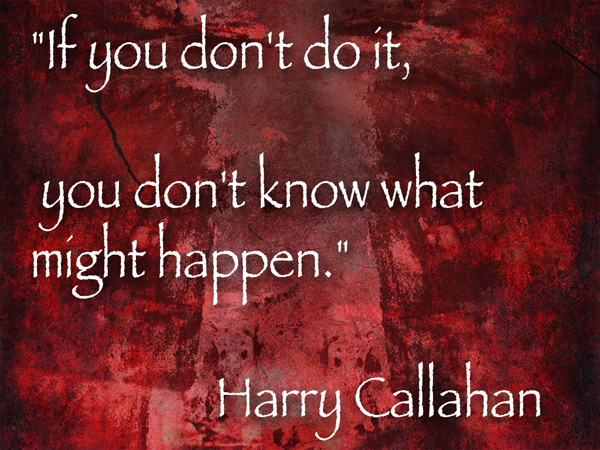
by successfulbob | inspiration, photographers health, photography - art quote, photography books, photography creativity, photography education
Sunday Photo/Art Quote – Do It
Ever talked yourself out of doing something?
You know. You want to try something new or exciting of different and the little voices start the Yam Yam Yammering away inside your brain with all the reasons something may not be a good idea. People won’t like it. It won’t turn out the way you think. It’s a waste of time. Yam, Yam and more Yam!
Turn the circus off. (more on How to do that in a moment!)
Right now lets turn to the quote of the day that inspired this post…
 “If you don’t do it, you don’t know what might happen.” Harry Callahan
“If you don’t do it, you don’t know what might happen.” Harry Callahan
Harry Callahan was a photographer inspired to pursue his career by a talk given by Ansel Adams. He was first and foremost an educator only producing about a half dozen finished images a year…
How to Quiet the Yam Yam Yam
Slow down.
Meditate.
Take time to practice meditation. The brain’s job, in addition to maintaining our living functions like breathing and heartbeat, is to create thoughts. Lots of thoughts. A real, lot, whole bunch of thoughts that can crowd our mind and create noise. (that was the circus I was referring to earlier) When the noise is on and you can’t concentrate then any thought that comes through, usually negative thoughts, can keep us from trying new things.
Meditation allows us to practice allowing those thoughts to move through without grabbing our full attention allowing us to concentrate on the things that can actually be of help. Whenever I suggest this there’s an almost immediate plethora of excuses , “But Bob, I can’t meditate, I don’t have time.” “I can never get my mind to calm down!” “I just can’t get the hang of it..” And all of those excuses are true until you begin the practice of meditation.
Have you ever learned to do anything without some training? And practice? And failure along the way? Of course not. Meditation is the same. Learn. Study. Practice and meditation will help you also. One book I found to be helpful is “Wherever You Go, There You Are” by Jon Kabot-Zin Easy read. Easy practice from someone who has been studying the mental and physical health benefits of meditation for many years.
Don’t let the naysayer of your brain keep you from pushing boundaries.
Yours in Creative Photography, Bob
PS – This meditation stuff can help make you healthier too! Let me know how it works for you…

Check out the book by clicking above. If you buy anything using the link Amazon will give me a small affiliate fee that costs you nothing and helps support this web site.
by successfulbob | art books, photography, photography books, photography marketing
Barry Lopez – Learning to See
I saw this chapter posted on another web site and I am looking forward to getting a copy of this to read the rest of this National Bestseller
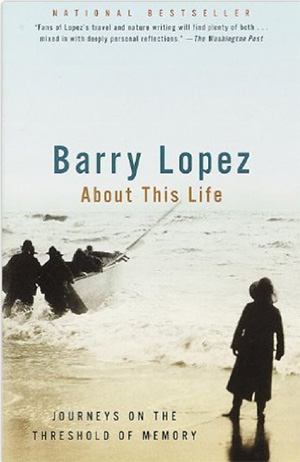 Barry Lopez book About This Life – Journeys on the Threshold of Memory
Barry Lopez book About This Life – Journeys on the Threshold of Memory
“The… event occurred around the first serious choice I made as a photographer to concentrate on a limited subject. The subject was always light, but I wanted to explore a single form, which turned out to be the flow of water in creeks and rivers near my home. I photographed in every season, when the water was high in February and March, when it was low in August, when it was transparent in July, when it was an opaque jade in December. In 1980 I began to photograph moving water in moonlight, exposures of twenty-five or thirty minutes. These images suffered from reciprocity failure – the color balance in them collapsed – but they also recorded something extraordinary, a pattern of flow we cannot actually see. They revealed the organizing principle logicians would one day call a strange attractor.
The streaming of water around a rock is one of the most complex motions of which human beings are aware. The change from a laminar, more or less uniform flow to turbulent flow around a single rock is so abstruse a transition mathematically that even the most sophisticated Cray computer cannot make it through to a satisfactory description.
Aesthetically, of course, no such difficulty exists. The eye dotes on the shift, delights in the scintillating sheeting, the roll-off of light around a rock, like hair responding to the stroke of a brush. Sometimes I photographed the flow of water in sunshine at 1/2000 of a second and then later I’d photograph the same rock in moonlight. Putting the photos side by side, I could see something hidden beneath the dazzle of the high-speed image that compared with our renderings of the Milky Way from space: the random pin-dot infernos of our own and every other sun form a spiraling, geometrical shape motionless to our eyes. In the moonlit photographs, the stray streaks from errant water splashes were eliminated (in light that weak, they occur too quickly to be recorded); what was etched on the film instead were orderly, fundamental lines of flow, created by particle after illuminated particle of gleaming water, as if each were a tracer bullet.
(Years later, reading Chaos, James Gleick’s lucid report on chaos theory, I would sit bolt upright in my chair. What I’d photographed was the deep pattern in turbulence, the clothing, as it were, of the strange attractor.)
“
– Barry Lopez, “Learning to See,” chapter 13 in About This Life

 Isis – Many of the elements were created from the manipulation of a single leaf. This includes the background, parts of her dress, and the hairpiece.
Isis – Many of the elements were created from the manipulation of a single leaf. This includes the background, parts of her dress, and the hairpiece. Urban Mermaids – Concept inspired by a regular model.
Urban Mermaids – Concept inspired by a regular model. Dance Within – One of the few images where Rouse used Corel Panter to help finish the look of the piece.
Dance Within – One of the few images where Rouse used Corel Panter to help finish the look of the piece. Rouse’s book ‘After the Camera’ is available on Amazon.
Rouse’s book ‘After the Camera’ is available on Amazon.










